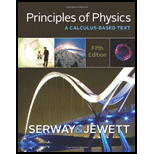
Concept explainers
(a)
The specific heat of unknown sample.
(a)
Answer to Problem 8P
The specific heat of unknown sample is
Explanation of Solution
Given info: The mass of the calorimeter is
Formula to calculate the heat lost by cooper block is,
Here,
Formula to calculate the heat lost by unknown sample is,
Here,
Formula to calculate the heat gained by the water is,
Here,
Formula to calculate the heat gained by calorimeter is,
Here,
From the conservation of energy, heat lost is equal to heat gained.
Substitute
Conclusion:
Therefore, the specific heat of unknown sample is
(b)
The specific heat of unknown sample.
(b)
Answer to Problem 8P
The unknown sample may be beryllium.
Explanation of Solution
Given info: The mass of the calorimeter is
The specific heat of unknown sample is
This value of specific heat is not given in the given table. So, it is difficult to make a definite identification of the sample. The closest value of this which is given in table is
Conclusion:
Therefore, the unknown sample may be beryllium.
(c)
To explain: The answer obtained in part (b).
(c)
Answer to Problem 8P
The specific heat may be defined as either the material having this amount of specific heat is not listed in the table or it may be an unknown alloy.
Explanation of Solution
The specific heat may be defined as the heat capacity per unit mass. It is the amount of heat per unit mass required to raise the temperature by
The value of specific heat obtained in part (b) does not correspond to any material given in table 19.1. So, either the material is not listed in the table or it may be an unknown alloy.
Conclusion:
Therefore, either the material having this amount of specific heat is not listed in the table or it may be an unknown alloy.
Want to see more full solutions like this?
Chapter 17 Solutions
Bundle: Principles of Physics: A Calculus-Based Text, 5th + WebAssign Printed Access Card for Serway/Jewett's Principles of Physics: A Calculus-Based Text, 5th Edition, Multi-Term
- Lab 8 Part 3 PHET Wave Interface simulation. I am having trouble with this part of the lab.arrow_forwardMick and Rick are twins born on Earth in the year 2175. Rick grows up to be an Earth-bound robotics technician while Mick becomes an intergalactic astronaut. Mick leaves the Earth on his first space mission in the year 2200 and travels, according to his clock, for 10 years at a speed of 0.75c. Unfortunately, at this point in his journey, the structure of his ship undergoes mechanical breakdown and the ship explodes. How old is Rick when his brother dies?arrow_forwardHi, I have canceled, why did you charge me again?arrow_forward
 Physics for Scientists and Engineers: Foundations...PhysicsISBN:9781133939146Author:Katz, Debora M.Publisher:Cengage Learning
Physics for Scientists and Engineers: Foundations...PhysicsISBN:9781133939146Author:Katz, Debora M.Publisher:Cengage Learning Principles of Physics: A Calculus-Based TextPhysicsISBN:9781133104261Author:Raymond A. Serway, John W. JewettPublisher:Cengage Learning
Principles of Physics: A Calculus-Based TextPhysicsISBN:9781133104261Author:Raymond A. Serway, John W. JewettPublisher:Cengage Learning College PhysicsPhysicsISBN:9781285737027Author:Raymond A. Serway, Chris VuillePublisher:Cengage Learning
College PhysicsPhysicsISBN:9781285737027Author:Raymond A. Serway, Chris VuillePublisher:Cengage Learning Physics for Scientists and Engineers, Technology ...PhysicsISBN:9781305116399Author:Raymond A. Serway, John W. JewettPublisher:Cengage Learning
Physics for Scientists and Engineers, Technology ...PhysicsISBN:9781305116399Author:Raymond A. Serway, John W. JewettPublisher:Cengage Learning Physics for Scientists and EngineersPhysicsISBN:9781337553278Author:Raymond A. Serway, John W. JewettPublisher:Cengage Learning
Physics for Scientists and EngineersPhysicsISBN:9781337553278Author:Raymond A. Serway, John W. JewettPublisher:Cengage Learning Physics for Scientists and Engineers with Modern ...PhysicsISBN:9781337553292Author:Raymond A. Serway, John W. JewettPublisher:Cengage Learning
Physics for Scientists and Engineers with Modern ...PhysicsISBN:9781337553292Author:Raymond A. Serway, John W. JewettPublisher:Cengage Learning





